Fairfax Stonehouse Farm is located at Dunsandel, Canterbury, New Zealand.
It is in its 14th season of an equity partnership. Carmen Ryan and Chris Hanrahan are the owner operators, with 35% of the share, while Ron and Adrienne Ferriman (retired dairy farmers) own the remaining 65%. In total, there are two dairy farms in this partnership.
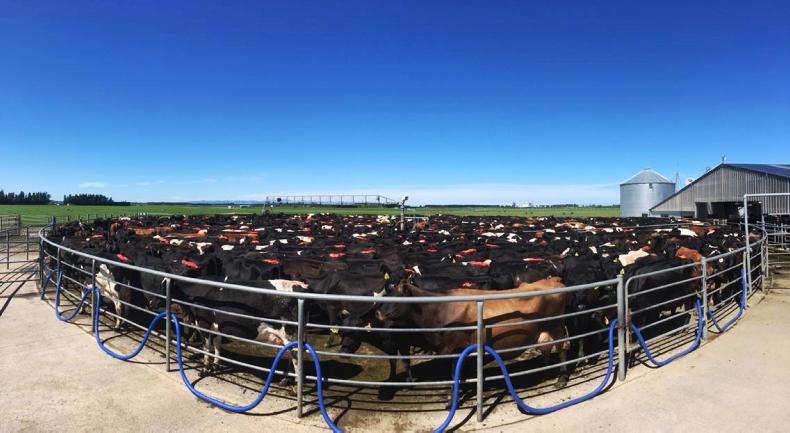
Cows in the collecting yard on Fairfax Stonehouse farm.
I started working here on 16 July 2019. The farm consists of a 680ac milking platform, with a 295ac irrigated run-off located 12km away from the farm and another 62ac leased from a neighbouring farm.
The milking parlour is a Waikato 60-bail rotary with automatic cup removers, grain and molasses feeding and protrack drafting.
The main aim of the farm is to exceed 470kg milk solids/cow regularly from 1,100 crossbred cows, with an emphasis on higher cow production.
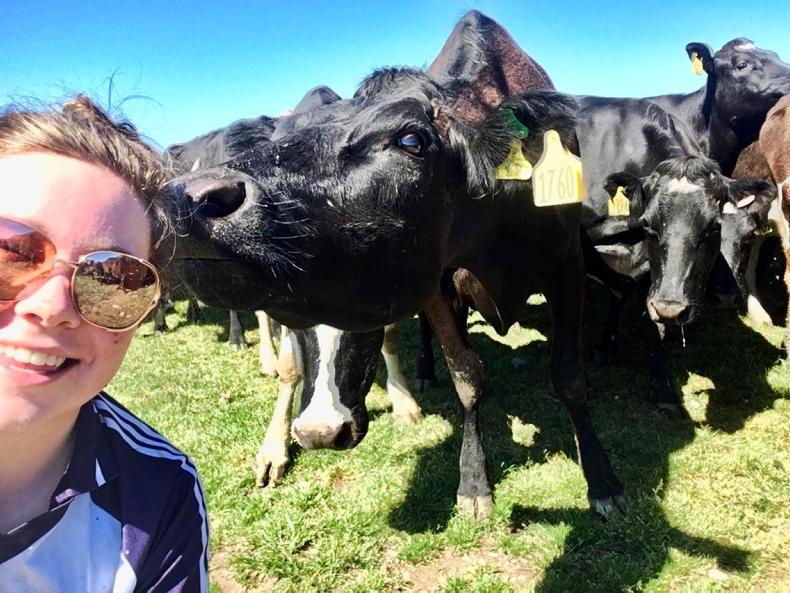
Marykate Condren with some of the cows on Fairfax Stonehouse farm.
There are six people employed full-time on this farm, as well as three full-time calf rearers.
Calving began on 12 July and finished on 20 October.
Breeding began on 23 October, with CIDRs being inserted and AI will be carried out for five weeks until the introduction of Jersey bulls on 1 December.
The farm is all spring-calving and cows are kept outdoors 365 days of the year.
Milking
Milking begins at 4.30am, with the first herd consisting of 550 cows and the second herd currently containing 560 cows.
During the calving season, the colostrum cows were rapid mastitis-tested, (RMT) before being milked four days post-calving and put into the milking herd.
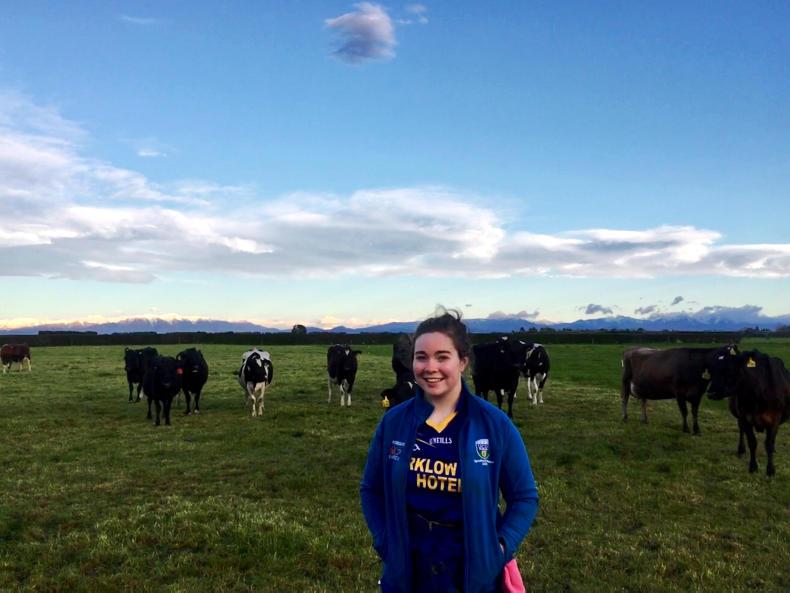
Marykate Condren on Fairfax Stonehouse farm where she is on placement.
Evening milkings begin at 1pm and the aim is to finish before 5pm.
Apart from milking, there are plenty of other jobs around the farm. After I bring the cows for milking, I set up new breaks for the herds.
The colostrum cows are currently on 100m2 of grass per cow per day, with the penicillin herd on 65m2 of grass per cow per day.
We started an 18-day rotation beginning 9 October, with three breaks being grazed from each of the paddocks.

Marykate Condren skydiving in New Zealand.
Grass growth in general has been good this year, with 80kg DM/ha grown daily.
It is measured on a weekly basis and the results are put into AgriNet, forming a grass wedge for the farm.
There has been an improvement in the weather and most days, temperatures reach the mid-teens. Irrigation also began on 9 October and at maximum flow, is spraying 155l of water per second on to the land.

Cows grazing on the Fairfax Stonehouse farm in New Zealand.
Another one of my responsibilities on the farm was to dust each of the herds with CalMag and lime flour to prevent cows suffering from milk fever.
Each cow received 50g of magnesium oxide daily, with milking herds also receiving 100g of lime flour per cow per day.
Calving
The first few weeks of calving were tough. Cows are out all year round and collecting calves on frosty, sometimes snowy mornings was an interesting experience – and with calves learning to walk and run within a short space of time, I soon warmed up on those cold mornings.
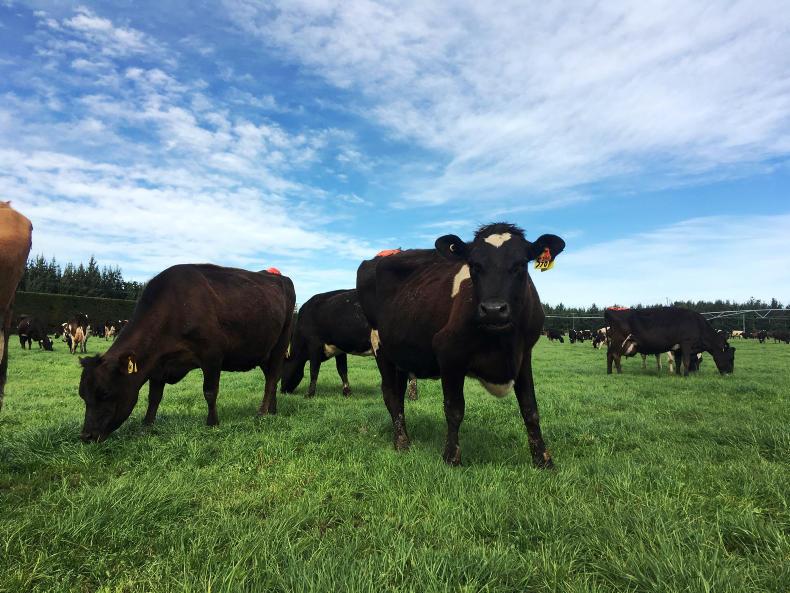
Cows on the Fairfax Stonehouse farm in New Zealand.
When the calves were six weeks old, I helped the calf rearers and vets to sedate, dehorn and DNA sample them.
Breeding started on 23 October and five weeks ago, I tail painted all the cows that were currently being milked at the time, with weekly checks and reapplication of the paint, if needed, being carried out since.
Social life
Apart from milking cows, there’s a great social life here in New Zealand.
We have managed to organise a Gaelic football team in our local town of Rakaia and we meet up for training weekly.
We are delighted to be taking part in a GAA tournament during labour weekend in Christchurch and jerseys have been ordered from O’Neill’s – we’ll surely have the luck of the Irish behind us then!
Read more
Student blog: one man, two dogs, 500ha and 2,500 ewes
Student blog: we need a bigger rain gauge in New Zealand
Student blog: calving season and thoughts towards breeding
Student blog: keeping milk cool and milking four times a day in Idaho
Fairfax Stonehouse Farm is located at Dunsandel, Canterbury, New Zealand.
It is in its 14th season of an equity partnership. Carmen Ryan and Chris Hanrahan are the owner operators, with 35% of the share, while Ron and Adrienne Ferriman (retired dairy farmers) own the remaining 65%. In total, there are two dairy farms in this partnership.

Cows in the collecting yard on Fairfax Stonehouse farm.
I started working here on 16 July 2019. The farm consists of a 680ac milking platform, with a 295ac irrigated run-off located 12km away from the farm and another 62ac leased from a neighbouring farm.
The milking parlour is a Waikato 60-bail rotary with automatic cup removers, grain and molasses feeding and protrack drafting.
The main aim of the farm is to exceed 470kg milk solids/cow regularly from 1,100 crossbred cows, with an emphasis on higher cow production.

Marykate Condren with some of the cows on Fairfax Stonehouse farm.
There are six people employed full-time on this farm, as well as three full-time calf rearers.
Calving began on 12 July and finished on 20 October.
Breeding began on 23 October, with CIDRs being inserted and AI will be carried out for five weeks until the introduction of Jersey bulls on 1 December.
The farm is all spring-calving and cows are kept outdoors 365 days of the year.
Milking
Milking begins at 4.30am, with the first herd consisting of 550 cows and the second herd currently containing 560 cows.
During the calving season, the colostrum cows were rapid mastitis-tested, (RMT) before being milked four days post-calving and put into the milking herd.

Marykate Condren on Fairfax Stonehouse farm where she is on placement.
Evening milkings begin at 1pm and the aim is to finish before 5pm.
Apart from milking, there are plenty of other jobs around the farm. After I bring the cows for milking, I set up new breaks for the herds.
The colostrum cows are currently on 100m2 of grass per cow per day, with the penicillin herd on 65m2 of grass per cow per day.
We started an 18-day rotation beginning 9 October, with three breaks being grazed from each of the paddocks.

Marykate Condren skydiving in New Zealand.
Grass growth in general has been good this year, with 80kg DM/ha grown daily.
It is measured on a weekly basis and the results are put into AgriNet, forming a grass wedge for the farm.
There has been an improvement in the weather and most days, temperatures reach the mid-teens. Irrigation also began on 9 October and at maximum flow, is spraying 155l of water per second on to the land.

Cows grazing on the Fairfax Stonehouse farm in New Zealand.
Another one of my responsibilities on the farm was to dust each of the herds with CalMag and lime flour to prevent cows suffering from milk fever.
Each cow received 50g of magnesium oxide daily, with milking herds also receiving 100g of lime flour per cow per day.
Calving
The first few weeks of calving were tough. Cows are out all year round and collecting calves on frosty, sometimes snowy mornings was an interesting experience – and with calves learning to walk and run within a short space of time, I soon warmed up on those cold mornings.

Cows on the Fairfax Stonehouse farm in New Zealand.
When the calves were six weeks old, I helped the calf rearers and vets to sedate, dehorn and DNA sample them.
Breeding started on 23 October and five weeks ago, I tail painted all the cows that were currently being milked at the time, with weekly checks and reapplication of the paint, if needed, being carried out since.
Social life
Apart from milking cows, there’s a great social life here in New Zealand.
We have managed to organise a Gaelic football team in our local town of Rakaia and we meet up for training weekly.
We are delighted to be taking part in a GAA tournament during labour weekend in Christchurch and jerseys have been ordered from O’Neill’s – we’ll surely have the luck of the Irish behind us then!
Read more
Student blog: one man, two dogs, 500ha and 2,500 ewes
Student blog: we need a bigger rain gauge in New Zealand
Student blog: calving season and thoughts towards breeding
Student blog: keeping milk cool and milking four times a day in Idaho







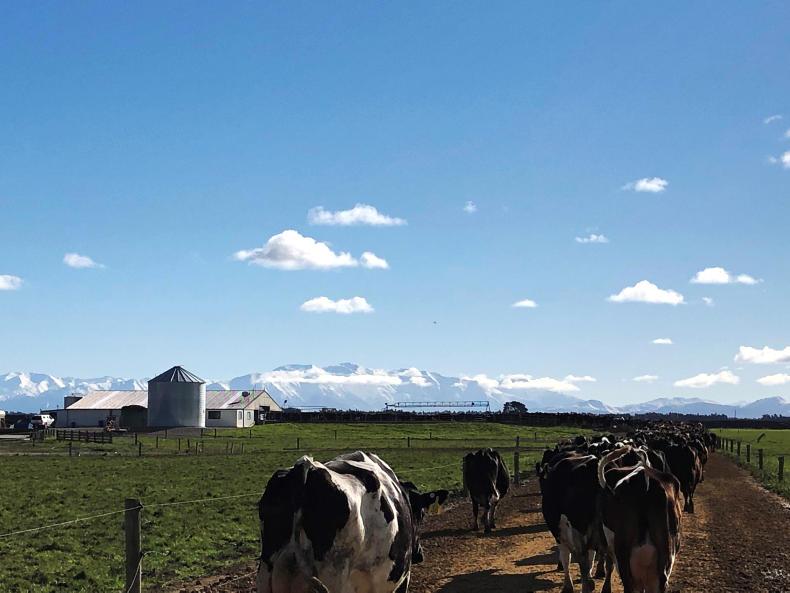




 This is a subscriber-only article
This is a subscriber-only article










SHARING OPTIONS: